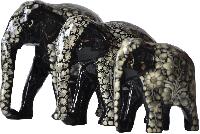
Paper Mache Elephants (Set of 3)
750 Per 750 Set
50` Set(s) (MOQ)
The inexplicable affinity of the artisan towards one of the most regal, intelligent and mysterious mammals on the planet, the mighty elephant, compels him to hand craft the miniature elephant set in utmost finesse. Hence he decides to hand make three miniature elephants in three different sizes and then hand paints them in bright little ruby flowers to adorn them in an illuminating fashion. Set your interiors class apart, as you choose to place these masterpieces on your living room shelves, and surprise your guests today and forever.About Paper MachePaper Mache is a delicate decorative art, born in Persia and brought to Kashmir by a Prince who spent years in a prison at Samarkand in Central Asia. The surroundings harnessed the creativity and romance for this art and finally Paper Mache took its roots in the simple homes and thus— a new art form was born. Paper Mache became the folk art of Kashmir; passing down from father to son, from generation to generation.

elephant statues
Get Price Quote
We source direct as well as indirect raw materials only from the certified vendors present in the market. Our team of quality experts strictly checks the entire range against varied parameters. We are supported by a reliable team of packaging experts who have immense experience in this domain and capable of catering to the standards and customized packaging requirements. Description : A symbol of strength, elephant statues can be created in various designs and sizes. Elephants with Trunk up are also made.
Best Deals from Animal Statues

Kashmiri Paper Mache Elephant
Get Price Quote
1 Piece (MOQ)
Paper mache was introduced to India in the 14th century by the Persian mystic Mir Syed Ali Hamdani. He was visiting the Kashmir region from Persia, and brought along skilled artisans and craftsmen.The Persian method of making paper mache melded with similar art forms from Central Asia, and a unique branch of the art of paper mache was born. Over time, Kashmiri artisans added their own flourishes to the art form, bringing attention to their creations from all around the world. There are two important aspects of Kashmiri paper mache- Sakhtsazi and Naqashi. The first step, Sakhtsazi, involves making the foundation of the paper mache figurine or object with the paper pulp, while Naqashi is the final step of painting and decoration. In the Sakhtsazi stage of making a Kashmiri paper mache item, the paper pulp is soaked in water for three or four days. It is then put in a stone mortar and ground so that all of the paper is uniform in its consistency. The pulp gets left in the sun to dry before being mixed with atji, a kind of rice glue. A mold made of clay or wood allows the artist to shape the paper and glue mixture around it. The paper is taken off the mold before it is completely dry, and then shaped and lacquered to make the outside smooth. After the item has gone through the smoothing process, a thin layer of butter paper protects the outside and will eventually keep the outer layer of paint from cracking off the finished product. During the Naqashi stage, a base coat of paint is applied. Then the artist makes their design by hand on the outside of the paper mache object, which means no Kashmiri paper mache item is the same. Traditional artists often use colors derived from minerals, organic, or vegetable bases. Common themes that appear on Kashmiri paper mache products include flowers, box patterns, jungle motifs, and Kashmiri symbols like almonds and the chinar, a five-pointed leaf.

Trunk Up Elephant
Get Price Quote